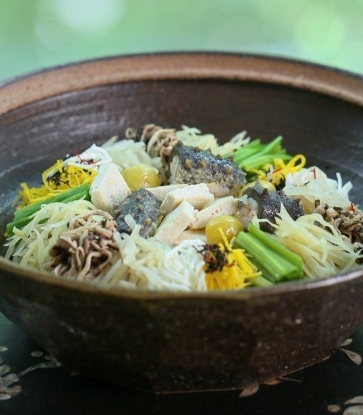Among Seoul’s ever-evolving culinary landscape, Geumdwaeji Sikdang — a beloved Bib Gourmand selection in the MICHELIN Guide — holds a distinct place. Celebrated by chefs, celebrities, and discerning food lovers alike, this humble yet exceptional spot is widely considered one of the most refined interpretations of Korea’s everyday palate. At the heart of its popularity lies a mastery of pork — grilled to perfection. But what lingers in the minds of many diners isn’t just the meat. It’s the kimchi jjigae — or kimchi stew.
Served at the end of the meal, Geumdwaeji Sikdang’s kimchi jjigae doesn’t play second fiddle to the main course — it delivers the final punch. Deeply fermented kimchi, generously cut pork belly, and a broth that’s both clear and full of depth — this stew doesn’t just conclude the meal; it crowns it.
Just as spring begins to stretch its limbs, kimchi jjigae reaches its peak. The kimchi, aged through winter, hits its stride in flavor, and with the cold slowly retreating, a steaming spoonful offers not just warmth, but something close to solace. At Geumdwaeji Sikdang, every batch of kimchi is made in-house, from salting to seasoning to aging. This homemade approach infuses not just the jjigae, but the entire menu, with a signature depth.
The journey begins with cabbage. Only firm, sweet cabbages are chosen, salted for 8 to 12 hours, rinsed, and drained. The seasoning — crafted from ground radish, garlic, ginger, and a blend of seafood sauces — is adjusted with kelp broth to the perfect consistency. Sliced scallions are folded in, and the paste is gently layered between the cabbage leaves. Once packed tightly into containers and sealed beneath outer leaves, the kimchi is left to ferment at below 2 degrees Celcius for at least six months. The result is kimchi with real character — complex, soulful, and ready to shine.
Once the kimchi is ready, it’s time to shine in the jjigae. First, it’s boiled in ample water over high heat. Then comes the pork — thick slices of belly and shoulder — followed by a hit of coarse chili powder and salt. The stew is simmered down through stages: medium, then low heat, allowing the flavors to concentrate and the meat to turn tender, almost silky. Tofu and scallions are added at the end, perfectly balancing the flavors of the dish.
Despite an ever-modernizing dining culture, the essence of kimchi jjigae endures — linking past and present, tradition and innovation.
Here is Geumdwaeji Sikdang’s original recipe for making kimchi and kimchi jjigae at home.
Kimchi (makes 20-25 kilograms)
Ingredients
20-25 kilograms, napa cabbage (around 10 heads)
1 radish (1.5kilograms)
700 grams, Korean chili powder
600 grams, garlic
150 grams, ginger
200 grams, salted shrimp
200 grams anchovy fish sauce
200 grams sand lance fish sauce
800 grams, scallions
Kelp broth (for adjusting consistency)
Coarse sea salt (for salting cabbage)
Instructions
1. Quarter the cabbages and salt them evenly. Let them sit for 8–12 hours, turning occasionally. Rinse thoroughly and drain.
2. Blend radish, garlic, ginger, and seafood sauces, then combine with chili powder. Adjust with kelp broth as needed.
3. Cut scallions into 5-centimeter lengths and mix into the seasoning.
4. Spread the seasoning between each cabbage leaf. Pack tightly into containers, cover with outer leaves, and ferment at room temperature for 24 hours.
5. Store in a kimchi fridge or cool storage below 2 degrees Celcius for at least 6 months.
Kimchi jjigae (serves 30-35)
Ingredients
10 kilograms, aged napa cabbage kimchi
20 liters, water
2 kilograms, pork belly
3 Kilograms, pork shoulder
320 grams, coarse chili powder
100 grams, salt
Tofu and scallions, to taste
Instructions
1. Place the kimchi and water into a large pot. Boil uncovered over high heat.
2. Once boiling, add large-cut pieces of pork, and season with chili powder and salt.
3. Lower to medium heat and simmer for 30 minutes, then to low heat for another hour.
4. Add tofu and scallions toward the end, simmer briefly, and serve hot.
















